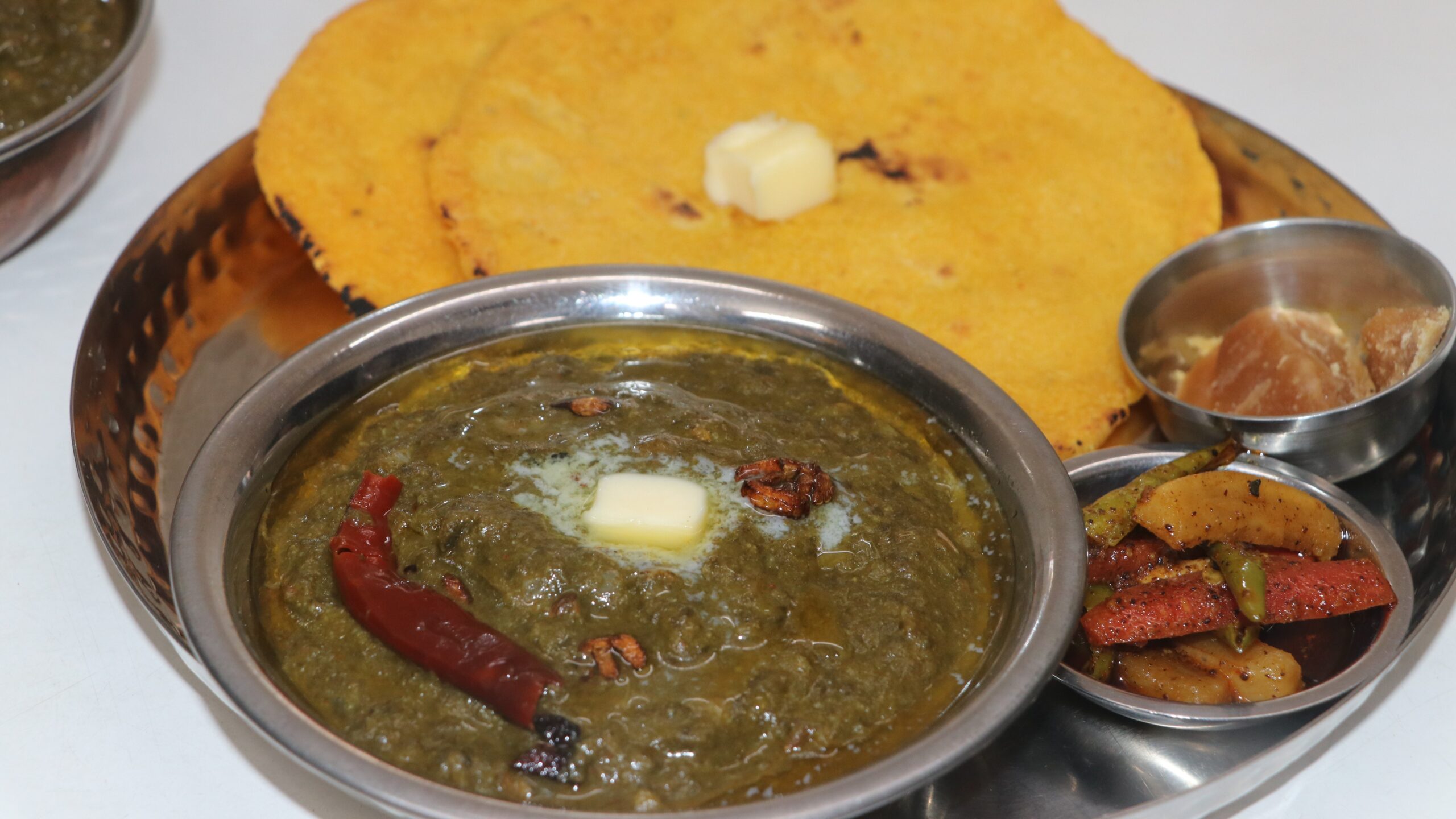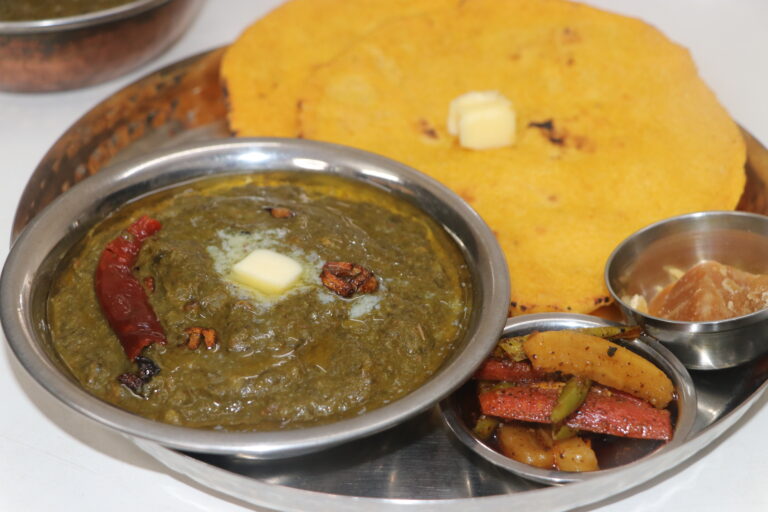As soon as winter arrives in North India, every Punjabi home begins to fill with the comforting aroma of Sarson ka Saag and Makki ki Roti. This dish isn’t just food—it is tradition, warmth, and nostalgia served in a bowl. Made with a blend of mustard greens, spinach, methi, and bathua, Sarson ka Saag is rich, wholesome, and incredibly nourishing for cold weather.
What makes this dish so special is its rustic texture and smoky, buttery flavor. Traditionally, it is slow-cooked in clay pots and ground on a stone sil-batta, giving it unmatched depth. But even at home, with simple steps, you can create a saag so authentic that it tastes straight from a Punjabi pind (village).
Let’s begin!
Do visit my other recipes, Veg Chili Mili with Paneer – A Colorful, Restaurant-Style Delight!
- Stuffed Paneer Paratha & Creamy Makhana Raita Recipe
- Mushroom Kaju Masala Recipe | Easy
- & quick Mushroom Cashew Masala,
- Kadu Puri with Aloo Matar ki Sabji,
- Lauki Kofta Curry recipe,
- Hotel Style Paneer Makhani Recipe,
- Dal Ki Dulhan | Dal Pitthi,
- Sev Tamatar Ki Sabji recipe,
- Lauki ki Sabji,
- Torai Ki Sabji ( Ridge Gourd),
- Kaju Paneer Masala Recipe,
- Paneer Korma,
- Palak Matar Paneer Recipe
- Zucchini ki sabji
- Dhaba Style Amritsari Chole Bhature
- Bedami Puri & Aloo ki Sabzi
- Protein-Rich Chole Paneer Recipe
- 10-minute Buttermilk Potato Curry (Aloo ki Chaas Wali Sabzi)
further, do check my other recipes collection All recipes
Ingredients
For the Saag
- Mustard leaves (sarson) – 1 bunch
- Spinach (palak) – ½ bunch
- Bathua leaves – ½ bunch
- Fresh methi leaves – ½ bunch
- Green chilies – 3 (chopped)
- Garlic – 1 tbsp (chopped)
- Ginger – ½ tsp (chopped)
- Salt – as per taste
- Corn flour – 4 tbsp (or use besan slurry)
- Water – as needed
For the Tadka (Tempering)
- Ghee – 2–3 tbsp (or mustard oil)
- Cumin seeds – ¼ tsp
- Dried red chilies – 2
- Garlic – ½ tsp (finely chopped)
- Onion – 1 (finely chopped)
- Tomato – 1 (paste or finely chopped)
- Red chili powder – ¼ tsp
- Coriander powder – ¼ tsp
- Jaggery – 1 tsp (optional, balances bitterness)
- Butter – 1 tsp (for topping)
Method
Step 1: Prepare and Clean the Greens
- Take 1 bunch of mustard greens. Keep the stems with 3 leaves on each stem—these give the saag its authentic flavor.
- Clean methi, bathua, and spinach.
- Wash all the greens 2–3 times thoroughly to remove soil.
- Drain and finely chop all the leaves.
Step 2: Cook the Saag
- In a large pot (or pressure cooker), add all chopped greens, Chopped green chilies – 3, Chopped garlic – 1 tbsp, Chopped ginger – 1/2 tsp, Salt as per taste, 1 glass water.
- Cover and cook on medium flame for 15–20 minutes, until the greens completely soften.
Step 3: Thicken and Mash the Saag
- Once the greens are soft, add 4 tbsp corn flour (or besan slurry).
- Mash well using a mathani (traditional whisk), or a hand masher, or pulse in a mixer for 2–3 seconds (do NOT puree).
- The texture should be coarse and rustic—this is the charm of real Punjabi saag.
Step 4: Prepare the Tadka
- Heat ghee or mustard oil in a kadhai.
- Add Cumin seeds – 1/4 tsp, Dried red chilies – 2, Chopped garlic – 1/2 tsp.
- Fry until the garlic turns golden.
- Add chopped onion – 1 and cook until it turns golden brown and caramelizes.
- Add chopped tomato – 1, and cook for 3–4 minutes until the masala releases oil.
- Add red chili powder and coriander powder. Fry well.
Step 5: Mix Tadka with Saag
- Add the saag mixture into the tadka.
- Add a little water to adjust consistency.
- Add 1 tsp jaggery to balance flavors (optional but recommended).
- Cover and cook on low flame for 20 minutes, stirring occasionally.. Saag splashes while boiling, so keep a lid partially covered. After 20 minutes, turn off the flame and add a dollop of butter on top.
Our Authentic Punjabi Sarson ka Saag is Ready! Serve it hot with Makki ki Roti, a piece of jaggery, pickle, and a glass of lassi. This combination is the soul of Punjabi winter food—simple, earthy, and irresistibly delicious.
Tips & Tricks –
- Don’t skip mustard stems. They add the real taste and depth.
- Add corn flour to get the perfect thick, rustic texture.
- A little jaggery balances the natural bitterness of mustard leaves.
- Mustard oil gives the most authentic flavor. But ghee works wonderfully too.
- Cook the saag slowly. The longer it simmers, the better the taste.
- Never fully blend the saag. It should be slightly coarse—not a smooth puree.




